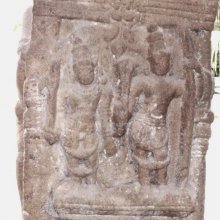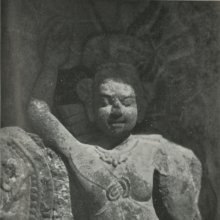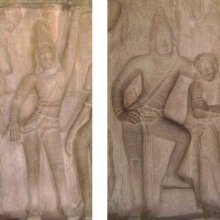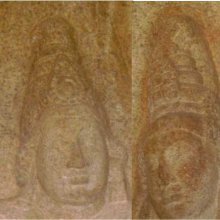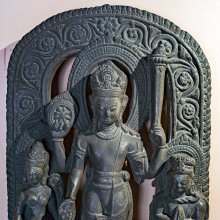Balarama, Balarāma, Bala-rama: 17 definitions
Introduction:
Balarama means something in Hinduism, Sanskrit, Jainism, Prakrit. If you want to know the exact meaning, history, etymology or English translation of this term then check out the descriptions on this page. Add your comment or reference to a book if you want to contribute to this summary article.
Images (photo gallery)
In Hinduism
Natyashastra (theatrics and dramaturgy)
Source: archive.org: The mirror of gesture (abhinaya-darpana)One of the Daśāvatāra (Hands of the Ten Avatars of Vishnu).—Balarāma: 1eft hand–Muṣṭi, right hand–Patāka.
Source: Shodhganga: Elements of Art and Architecture in the Trtiyakhanda of the Visnudharmottarapurana (natya)Balarāma (बलराम) or Balarāmāvatāra refers to one of the Daśāvatāra (“ten incarnations”) (of Lord Viṣṇu) to which are assign various hand gestures (in Indian Dramas), according to the Viṣṇudharmottarapurāṇa, an ancient Sanskrit text which (being encyclopedic in nature) deals with a variety of cultural topics such as arts, architecture, music, grammar and astronomy.—In the Hindu scriptures, different stories are found, related to lord Viṣṇu, where we find the magnanimity of different incarnations of lord Viṣṇu. Moreover, a great influence of these ten incarnations of lord Viṣṇu (e.g., Balarāma-avatāra) seems to fall in the field of Dance also.

Natyashastra (नाट्यशास्त्र, nāṭyaśāstra) refers to both the ancient Indian tradition (shastra) of performing arts, (natya—theatrics, drama, dance, music), as well as the name of a Sanskrit work dealing with these subjects. It also teaches the rules for composing Dramatic plays (nataka), construction and performance of Theater, and Poetic works (kavya).
Purana and Itihasa (epic history)
Source: Cologne Digital Sanskrit Dictionaries: The Purana Index
Balarāma (बलराम).—A son of Vasudeva1 and Rohiṇī and an aṃśa of Hari; (also Baladeva, Balabhadra, Sīrāyudha); the dhāma of Hari in the womb of Devakī transferred to that of Rohiṇī by Yogamāyā; on account of this he is Saṅkarṣaṇa; also Rāma on account of his pleasant personality and Bala on account of his strength; his nāmakaraṇa;1 was bewildered at Baka seizing Kṛṣṇa; became glad at his escape; entered the palmyra grove, vanquished the Asura Dhenuka and his kin and gladdened the cow-herds; advised Nanda and others to keep cool when Kṛṣṇa was enclosed in the coils of the reptile, and stopped their getting into the pool of Kālīya; his joy at Kṛṣṇa's escape from Kālīya; was carried by Pralamba on his back when he won in a certain game; but finding him to be an Asura in the guise of a gopa, he knocked his head with his fist and killed him for which the Devas praised him;2 his surprise at Kṛṣṇa's holding aloft the Govardhana; was in charge of the women rescued by Kṛṣṇa from Śankhacūḍa and was presented with the Cūḍāmaṇi of Śankhacūḍa.3
- 1) Bhāgavata-purāṇa IX. 3. 33-6; X. 1. 8; 2. 8 and 13; 8. 11-13; Viṣṇu-purāṇa IV. 13. 99; 15. 19; V. 8. 11; 9. 34; 17. 23; 18. 11 and 36.
- 2) Bhāgavata-purāṇa IX. 3. 33-6; X. 1. 8; 2. 8 and 13; 8. 11-13; Viṣṇu-purāṇa IV. 13. 99. 15. 19; V. 8. 11; 9. 34; 17. 23; 18. 11 and 36.
- 3) Bhāgavata-purāṇa X. 11. 49, 53; 15. 28-38; 16. 22; 17. 15; 18. 3, 24-32; 26. 11.

The Purana (पुराण, purāṇas) refers to Sanskrit literature preserving ancient India’s vast cultural history, including historical legends, religious ceremonies, various arts and sciences. The eighteen mahapuranas total over 400,000 shlokas (metrical couplets) and date to at least several centuries BCE.
Vyakarana (Sanskrit grammar)
Source: Wikisource: A dictionary of Sanskrit grammarBalarāma (बलराम).—Writer of a gloss named धातुप्रकाश (dhātuprakāśa) on the Dhatupatha of Panini.

Vyakarana (व्याकरण, vyākaraṇa) refers to Sanskrit grammar and represents one of the six additional sciences (vedanga) to be studied along with the Vedas. Vyakarana concerns itself with the rules of Sanskrit grammar and linguistic analysis in order to establish the correct context of words and sentences.
Shilpashastra (iconography)
Source: Shodhganga: The significance of the mūla-beras (śilpa)Balarāma (बलराम) or Balarāmāvatāra refers to one the “ten incarnations of Lord Viṣṇu”, as defined according to texts dealing with śilpa (arts and crafs), known as śilpaśāstras.—The hand gestures for the daśāvatāra in dancing and iconography are similar in some cases and dissimilar in most of the cases. The balarāma-avatāra-hasta in dance is depicted with the right hand and the left hand in patāka and muṣṭi-hastas respectively. In images, Balarāma is depicted with gadā and koumadaki and sometimes with bow and arrow in vaiṣṇava-sthānaka. The hands assume śikhara-hasta, denoting the act of ploughing. The distinctive emblem of this god is the plough which he holds in his right hand in muṣṭi or śikhara and the other hand hangs loose in the images.

Shilpashastra (शिल्पशास्त्र, śilpaśāstra) represents the ancient Indian science (shastra) of creative arts (shilpa) such as sculpture, iconography and painting. Closely related to Vastushastra (architecture), they often share the same literature.
Vaishnavism (Vaishava dharma)
Source: Pure Bhakti: Brhad BhagavatamrtamBalarāma (बलराम) refers to:—Śrī Kṛṣṇa’s brother and first expansion, renowned for His strength. (cf. Glossary page from Śrī Bṛhad-bhāgavatāmṛta).

Vaishnava (वैष्णव, vaiṣṇava) or vaishnavism (vaiṣṇavism) represents a tradition of Hinduism worshipping Vishnu as the supreme Lord. Similar to the Shaktism and Shaivism traditions, Vaishnavism also developed as an individual movement, famous for its exposition of the dashavatara (‘ten avatars of Vishnu’).
General definition (in Hinduism)
Source: Apam Napat: Indian MythologyBalarama was the brother of Krishna. He was a matchless warrior with the mace and was the teacher of both Bheema and Duryodhana. He wanted to take part in the war on the side of Duryodhana, but as his brother Krishna was on the Pandava side, he decided to remain neutral.
Source: WikiPedia: HinduismBalarāma (बलराम): Elder brother of Lord Krishna and manifestation of Sheshanaga.
-- or --
Balarāma (बलराम): An avatar or incarnation of Adisesha the thousand-hooded serpent on which Lord Mahavishnu reclines in Vaikuntha.
In Jainism
General definition (in Jainism)
Source: WikiPedia: JainismBalarāma (बलराम) (or Baladeva, Balabhadra, Rāma, Bala) refers to a set of nine “gentle heroes” and half-brothers of Vasudevas (or Viṣṇus, Nārāyaṇas), mentioned in both Śvetāmbara and Digambara literature.—In every half time cycle, there are 9 sets of Balabhadras (gentle heroes), Vasudevas (violent heroes) and Prativāsudevas (anti-heroes). Baladevas, half-brothers of Vasudevas, are described as fair in complexion and wear garments of dark blue and have a banner of palm tree. Their symbols or weapons are: bow, plough, pestle and arrow. The two brothers are inseparable and they jointly rule three continents as half-Chakravarti. Although Narayana is the mightier of the two, Balabhadra is depicted as superior for his non-violent ways and he achieves liberation. According to the Jain puranas, the Balabhadras lead an ideal Jain life.

Jainism is an Indian religion of Dharma whose doctrine revolves around harmlessness (ahimsa) towards every living being. The two major branches (Digambara and Svetambara) of Jainism stimulate self-control (or, shramana, ‘self-reliance’) and spiritual development through a path of peace for the soul to progess to the ultimate goal.
Languages of India and abroad
Sanskrit dictionary
Source: DDSA: The practical Sanskrit-English dictionaryBalarāma (बलराम).—'the strong Rāma', Name of the elder brother of Kṛṣṇa. [He was the seventh son of Vasudava and Devakī; but transferred to the womb of Rohiṇī to save him from falling a prey to the cruelty of Kaṃsa. He and his brother Kṛṣṇa were brought up by Nanda in Gokula. When quite young, he killed the powerful demons Dhenuka and Pralamba, and performed, like his brother, many feats of surprising strength. On one occasion Balarāma under the influence of wine, of which he was very fond, called upon the Yamunā river to come to him that he might bathe; and on his command being unheeded, he plunged his plough-share into the river and dragged the waters after him, until the river assumed a human form and asked his forgivenss. On another occasion he dragged towards himself the whole city of Hastināpura along with its walls. As Kṛṣṇa was a friend and admirer of the Pāṇḍavas, so Balarāma was of the Kauravas, as was seen in his desire of giving his sister Subhadrā to Duryodhana rather than to Arjuna; yet he declined to take any part in the great Bhāratī war either with the Pāṇḍavas or the Kauravas. He is represented as dressed in blue clothes, and armed with a ploughshare which was his most effective weapon. His wife was Revatī. He is sometimes regarded as an incarnation of the serpent Śeṣa and sometimes as the eighth incarnation of Viṣṇu; see the quotation under हल (hala)].
Derivable forms: balarāmaḥ (बलरामः).
Balarāma is a Sanskrit compound consisting of the terms bala and rāma (राम).
Source: Cologne Digital Sanskrit Dictionaries: Shabda-Sagara Sanskrit-English DictionaryBalarāma (बलराम).—m.
(-maḥ) The demi-god named Balarama, half brother to Krishna, and the third of the Ramas; according to some, the eighth Avatar of Vishnu. E. bala strength, ram to sport, aff. ghañ .
Source: Cologne Digital Sanskrit Dictionaries: Benfey Sanskrit-English DictionaryBalarāma (बलराम).—m. the third Rāma, the half-brother of Kṛṣṇa, Mahābhārata 1, 7912. Cf. rāma-candra.
Balarāma is a Sanskrit compound consisting of the terms bala and rāma (राम).
Source: Cologne Digital Sanskrit Dictionaries: Cappeller Sanskrit-English DictionaryBalarāma (बलराम).—[masculine] = baladeva.
Source: Cologne Digital Sanskrit Dictionaries: Monier-Williams Sanskrit-English DictionaryBalarāma (बलराम):—[=bala-rāma] [from bala > bal] m. Name of the elder brother of Kṛṣṇa and third of the Rāmas (regarded as the 8th Avatāra of Viṣṇu, sometimes as an incarnation of the great serpent Śeṣa or An-anta; he is also called Bala, Bala-deva, Bala-bhadra, and Halāyudha, cf. [Indian Wisdom, by Sir M. Monier-Williams 332 etc.]), [Mahābhārata; Purāṇa]
Source: Cologne Digital Sanskrit Dictionaries: Yates Sanskrit-English DictionaryBalarāma (बलराम):—[bala-rāma] (maḥ) 1. m. Balarāma; the half brother to Krishna.
[Sanskrit to German]
Sanskrit, also spelled संस्कृतम् (saṃskṛtam), is an ancient language of India commonly seen as the grandmother of the Indo-European language family (even English!). Closely allied with Prakrit and Pali, Sanskrit is more exhaustive in both grammar and terms and has the most extensive collection of literature in the world, greatly surpassing its sister-languages Greek and Latin.
See also (Relevant definitions)
Starts with: Balarama pancanana, Balaramabharata, Balaramapancanana, Balaramavatara, Balaramayana.
Full-text (+300): Langaladhvaja, Nishatha, Haladhara, Talabhrit, Balala, Taladhvaja, Sirin, Revatiramana, Kalindikarshana, Talalakshman, Priyamadhu, Halayudha, Halabhrit, Hala, Ekakundala, Langalin, Revatisha, Ramacara, Revati, Halin.
Relevant text
Search found 83 books and stories containing Balarama, Balarāma, Bala-rama, Bala-rāma; (plurals include: Balaramas, Balarāmas, ramas, rāmas). You can also click to the full overview containing English textual excerpts. Below are direct links for the most relevant articles:
Garga Samhita (English) (by Danavir Goswami)
Verse 5.1.12 < [Chapter 1 - Advice to Kaṃsa]
Verse 5.9.10 < [Chapter 9 - The Happiness of the Yadus]
Verse 5.14.36 < [Chapter 14 - The Meeting of King Nanda and Uddhava]
The Agni Purana (by N. Gangadharan)
Chapter 12 - Manifestation of Viṣṇu as Kṛṣṇa
Chapter 275 - Description of the dynasty of Yadu (yaduvaṃśa)
Shishupala-vadha (Study) (by Shila Chakraborty)
Amātya in the Śiśupālavadha < [Chapter 2b - Activities of Minister (Amātya)]
Ṣāḍguṇya in the Śiśupālavadha < [Chapter 3 - Six fold policies of a king (Ṣāḍguṇya)]
Marching time (towards the enemy) < [Chapter 1 - Concept of Vijigīṣu king]
Bhakti-rasamrta-sindhu (by Śrīla Rūpa Gosvāmī)
Verse 4.8.38 < [Part 8 - Compatible & Incompatible Mellows (maitrī-vaira-sthiti)]
Verse 2.4.37 < [Part 4 - Transient Ecstatic Disturbances (vyābhicāri-bhāva)]
Verse 3.3.25 < [Part 3 - Fraternal Devotion (sakhya-rasa)]
Trishashti Shalaka Purusha Caritra (by Helen M. Johnson)
Part 1: Introduction < [Chapter I]
Introduction to volume 5 < [Introductions]
Part 16: Gośāla’s misconduct < [Chapter III - Mahāvīra’s first six years as an ascetic]
The Killing of Pralamba < [Fifth Section]
Balarama and The River Yamuna < [Fifth Section]
Rukmini and Rukmi < [Fifth Section]
Related products
